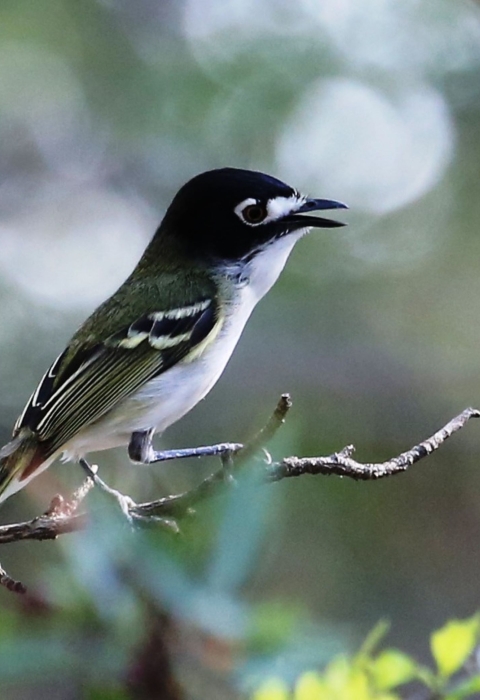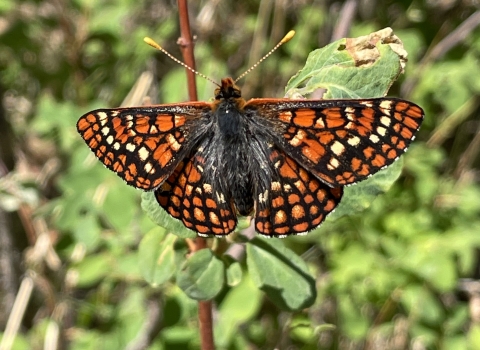Not so long ago the black-capped vireo nearly went extinct. Goats ate their way through this songbird’s habitat and brown-headed cowbirds commandeered their nests. In the late 1980s there were only about 350 birds known to exist, but thanks to robust conservation efforts, the small songbird is being removed from the list of endangered and threatened species.
The U.S. Fish and Wildlife Service joined forces with the states of Oklahoma and Texas, the U.S. Army, private landowners and non-governmental organizations to protect and recover the vireo. Through the dedicated conservation efforts undertaken by these partners to address primary threats, conserve needed habitat and advance scientific understanding, the vireo has experienced a dramatic recovery. There are now more than 14,000 birds estimated across the vireo’s breeding range of Oklahoma, Texas and Mexico.
Today, the U.S. Fish and Wildlife Service celebrated the partnership driven recovery of the black-capped vireo at Balcones Canyonlands National Wildlife Refuge with many of those involved in the recovery effort. “The delisting of the black-capped vireo clearly illustrates the value of the Service’s partnership-driven approach to conservation,” said Amy Lueders, the Service’s Southwest Regional Director. “By working with our partners including Fort Hood, Fort Sill, the states of Texas and Oklahoma, private landowners and others we were able to conserve a North American songbird that once perched on the brink of extinction for future generations to enjoy.”
“Anytime we are able to successfully recover an imperiled species and see it removed from the endangered species list is cause for celebration”, said Carter Smith, Executive Director of Texas Parks and Wildlife Department. “What made it all work were the tireless efforts and dedication of multiple public and private partners, particularly the commitment of private landowners who labored diligently to restore and enhance habitats to benefit the vireos and a host of other native species in the process. The conservation lesson learned here is that marriage of good partnerships and good land stewardship produces results we can all be proud of.”
“The black-capped vireo is a success story that shows the power of conservation partnerships,” said J.D. Strong, director of the Oklahoma Department of Wildlife Conservation. “Now our challenge is to redouble efforts to make sure those partnerships continue – along with valuable habitat restoration work and research – so that vireos and Oklahoma’s other fish and wildlife populations remain healthy.
"I’m proud of our Natural Resources team for their application of sound science to demonstrate military training is compatible with the black capped vireo recovery. I also appreciate the efforts of the U.S. Fish and Wildlife Service to fully understand our training and readiness requirements, striking a balance between Fort Hood’s mission and endangered species management,” said Colonel Henry Perry, Commander, U.S. Army Garrison Fort Hood. "This delisting results from decades of collaboration between the Fish and Wildlife Service and stakeholders like Fort Hood."
The black-capped vireo was listed in 1987 primarily due to the impacts of habitat loss and nest parasitism by brown-headed cowbirds. Cowbirds dupe the vireos into raising cowbird chicks at the cost of the survival of their own young. In addition, during this time-period Texas had a prevalence of goats on the landscape that were browsing on shrubs and reducing the shrub cover that vireos need.
Across Texas and Oklahoma, the Service worked with the U.S. Army, Oklahoma Department of Wildlife Conservation, Texas Parks and Wildlife Department, U.S. Department of Agriculture, The Nature Conservancy, the Environmental Defense Fund and others on efforts to recover the black-capped vireo. A concerted program to manage cowbirds and restore habitat, as well as the decrease in goat densities in Texas since the repeal of the National Wool Act, resulted in increased numbers of vireos across the breeding range. Conservation efforts included using prescribed fire, creating conservation easements, and research and management of brown-headed cowbirds.
The black-capped vireo is the smallest member of the vireo family occurring regularly in the United States. It winters exclusively in Mexico along the Pacific Coast. Sporting a namesake black cap and white face mask, black-capped vireos build intricate hanging-cup nests two to four feet above the ground fastened to the branches of shrubs with strands from spider webs. They return to the same breeding site year after year.
Using a scientifically rigorous Species Status Assessment, the Service found that the primary threats to the black-capped vireo have been reduced or adequately managed and populations are expected to be viable in the future.
To ensure black-capped vireo populations remain healthy and stable into the future, the Service has developed a post delisting monitoring plan with the states of Texas and Oklahoma, Fort Hood, Fort Sill and The Nature Conservancy of Texas. The plan describes the methods we will use to monitor the status of the vireo and its habitat, in cooperation with our partners for a 12-year period and provides a strategy for identifying and responding to any future population declines or habitat loss.
America’s fish, wildlife, and plant resources belong to all of us, and ensuring the health of imperiled species is a shared responsibility. The Service works actively to engage conservation partners and the public in the search for improved and innovative ways to conserve and recover imperiled species.



